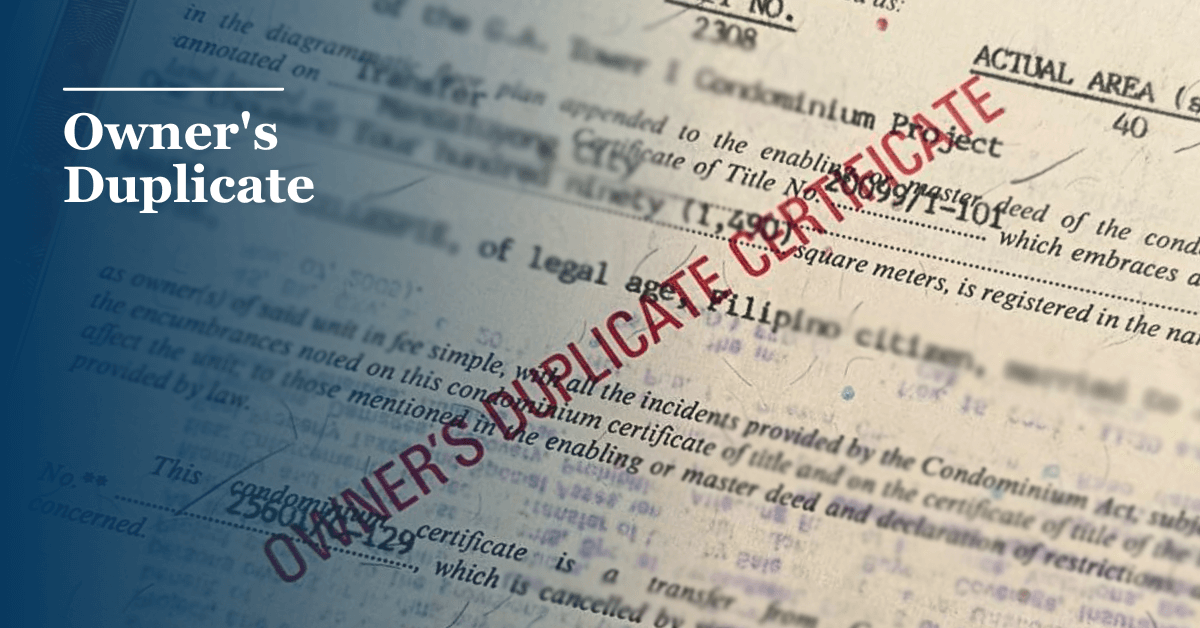In the realm of land title registration, the certificate of title stands as indisputable evidence of ownership, providing an unwavering guarantee of property rights. Within this context, the owner’s duplicate copy of the title assumes critical importance. Recent legal rulings, such as the Supreme Court’s decision in The Heirs of Alfredo Cullado v. Gutierrez(G.R. No. 212938, July 30, 2019), have reinforced the significance of this document, emphasizing its role in preserving the integrity of the Torrens system and instilling confidence in land transactions. This article delves into the essence of the owner’s duplicate copy of the title, shedding light on its irreplaceable function and the legal framework surrounding its use.
The Indefeasibility and Incontrovertibility of Land Titles:
At the core of the Torrens system lies the principle of indefeasibility and incontrovertibility, wherein the certificate of title serves as irrefutable evidence of ownership. As enunciated in The Heirs of Alfredo Cullado v. Gutierrez, the government’s adoption of the Torrens system aims to ensure the protection and inviolability of land titles. By possessing a registered title, property owners can find solace in the knowledge that their ownership rights remain secure, as long as no voluntary disposals of rights occur. Simultaneously, prospective buyers can rely on the registered owner’s title, shielded from the risk of later discovering their acquisition to be ineffective. This certainty fosters public trust in the system and simplifies land transactions.
The Significance of the Owner’s Duplicate Certificate:
Presidential Decree No. 1529, commonly referred to as the “Property Registration Decree,” mandates the issuance of the certificate of title in duplicate form. The original certificate is retained by the Register of Deeds, while the owner’s duplicate copy is entrusted to the registered owner. This dual certification process ensures the preservation of land ownership records and enables the secure exercise of property rights.
Role in Voluntary Transactions and Registration:
In voluntary dealings involving registered land, the owner’s duplicate certificate plays a crucial role. For example, consider a scenario where a registered landowner wishes to sell their property. The prospective buyer relies on the registered owner’s title and the presentation of the owner’s duplicate certificate during the transaction. By providing the owner’s duplicate certificate, the registered owner grants conclusive authority to the Register of Deeds to execute a new certificate or make a registration memorandum based on the sale agreement. This requirement protects both the registered owner and subsequent purchasers for value and in good faith, guaranteeing the validity and enforceability of the transaction.
Similarly, let’s imagine a landowner who wants to mortgage their registered land. In this case, the lender will insist on the presentation of the owner’s duplicate certificate before proceeding with the mortgage transaction. The mortgage agreement, supported by the owner’s duplicate certificate, grants the lender a legal claim over the property as collateral. This ensures that the mortgage is binding on third parties and provides security for the lender’s investment.
The Protective Shield of the Owner’s Duplicate Certificate:
The possession of the owner’s duplicate certificate offers registered owners security and peace of mind. It serves as a tangible safeguard against fraudulent registrations and ensures that voluntary transactions affecting the land are binding on third parties. Without the owner’s duplicate certificate, transfers and conveyances like sales and donations, mortgages, leases, and agencies and trusts, while valid, will not bind the registered land and third parties. Therefore, the owner’s duplicate certificate acts as a shield, fortifying the registered owner’s rights and protecting them from encroachments on their property.
The owner’s duplicate copy of the title is an indispensable component of the Torrens system, upholding the principles of indefeasibility and incontrovertibility of land titles. By adhering to the requirement of presenting the owner’s duplicate certificate for voluntary transactions, the system provides security for registered owners and fosters confidence in land transactions. Real-world examples of voluntary transactions such as sales and mortgages demonstrate the essential role played by the owner’s duplicate certificate in ensuring the validity and enforceability of such dealings. As the legal landscape continues to evolve, recognizing the importance of the owner’s duplicate copy of the title remains crucial for preserving property rights and maintaining the efficiency and reliability of the land registration system.
Considering the importance of the owner’s duplicate certificate of title, in the event of the loss or destruction of the owner’s duplicate certificate of title, what are the implications and remedies available?
Losing the owner’s duplicate copy of a title can create challenges in establishing ownership of a property. Fortunately, the Philippines has specific legal provisions to address this situation. When it comes to petitions for the issuance of new owners’ duplicate certificates of title in cases of loss, theft, or destruction, the applicable law is Section 109 of Presidential Decree No. 1529.
Section 109 of PD 1529 provides that in case of loss, theft, or destruction of an owner’s duplicate certificate of title, the owner or a representative must promptly send a sworn notice to the Register of Deeds where the property is located. If the duplicate certificate is lost, destroyed, or cannot be produced, a sworn statement detailing the circumstances must be filed by the registered owner or an interested party.
Upon petition by the registered owner or another party with a stake in the property, the court, after proper notice and hearing, can direct the issuance of a new duplicate certificate. This new certificate will carry a memorandum indicating that it replaces the lost or destroyed one. It will possess the same legal standing and credibility as the original duplicate.
To summarize the requirements for replacing a lost owner’s duplicate certificate of title:
- The registered owner or an interested party must immediately notify the Register of Deeds about the loss or destruction of the owner’s duplicate certificate.
- A petition for the replacement of the lost or destroyed certificate must be filed in court using the original case in which the registration was entered.
- The petition should be supported by an oath providing detailed information regarding the loss or destruction.
- After due notice to the Register of Deeds and all interested parties mentioned in the encumbrances noted in the original or transfer certificate of title, the court will schedule a hearing on the petition.
- Following the hearing, the court may order the issuance of a new duplicate certificate that contains a memorandum stating that it replaces the lost or destroyed one. The new certificate will have the same legal validity as the original.
It is important to note that Section 41 of PD 1529 requires the delivery of the owner’s duplicate certificate of title to the registered owner or their authorized representative. Therefore, it is typically the registered owner who files the petition for reconstitution when their duplicate copy is lost or destroyed. Other parties with an interest in the property, such as mortgagees, must be notified to protect their rights and ensure the continuity of encumbrances.
However, Section 109 of PD 1529 also allows for situations where a person other than the registered owner, such as a transferee of ownership, files the petition for reconstitution. In such cases, both the registered owner and other interested parties must be notified to safeguard their rights.
Notifying the registered owner in a petition for reconstitution of a lost or destroyed owner’s duplicate certificate of title is crucial to prevent potential fraud. The presumption of the registered owner’s ownership gives them preferential rights over the owner’s duplicate. The proper notice allows the registered owner to contest any claims made by the petitioner, ensuring a fair and orderly process.
In summary, the loss or destruction of the owner’s duplicate copy of a title can be remedied through a petition for the issuance of a new duplicate certificate. By adhering to the prescribed procedures and providing proper notice to all relevant parties, including the registered owner, the integrity of the registration system is upheld, and the rights of all parties involved are protected.




